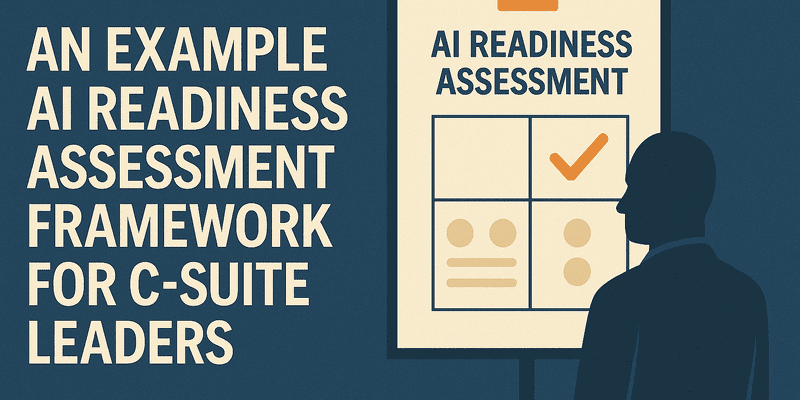An Example AI Readiness Assessment Framework for C Suite Leaders

Tim King offers an example AI readiness assessment framework for C Suite leaders, part of Solutions Review’s coverage on the human impact of AI.
There is no one-size-fits-all blueprint for artificial intelligence. Every organization has its own legacy systems, workforce culture, regulatory pressures, and innovation appetite. But one thing is universally true: AI success depends on readiness. Not just technical readiness, but ethical, emotional, and operational readiness across the entire enterprise.
But as the pressure to “implement AI now” mounts, many organizations rush in without a clear framework for what it means to be ready. They focus on models, tools, and talent—but overlook the critical dimensions of ethics, empathy, and impact.
That’s where this guide comes in.
This is not just another AI readiness assessment framework. It’s the web’s most comprehensive AI readiness framework—designed for forward-thinking enterprises that want to build AI systems with precision and compassion. Here, readiness isn’t just about deploying algorithms. It’s about aligning leadership, securing data foundations, preparing your people, governing responsibly, and measuring what matters most.
Each section introduces a vital readiness domain, complete with a custom-built web tool to help you assess, align, and act. From executive strategy to redress mechanisms, this is your roadmap to building AI that is not only scalable, but sustainable—and above all, human-centered.
Important: AI Won’t Replace You, But Lack of Soft Skills Might – Get Report
AI Readiness Assessment Framework for C Suite Leaders
Organizational Alignment & Strategy
Before your organization implements a single AI model, the most important question to answer is why. Why are you investing in artificial intelligence? What do you hope to achieve—and how will success be defined? These questions may seem obvious, but many enterprises skip them in their race to innovate, only to find themselves managing fragmented pilots, duplicated tooling, or deeply misaligned expectations.
AI cannot be treated as a plug-and-play technology. It is a transformative capability that affects people, processes, and power structures across the organization. As such, AI readiness must begin with strategic alignment across leadership. Executive teams need to agree on what AI means for the business, which areas of the enterprise will be prioritized for AI deployment, and how those priorities serve broader business, social, or operational goals.
An empathetic enterprise doesn’t just pursue AI for efficiency—it pursues it for long-term value that respects its people, partners, and customers. But even empathetic intent can falter without internal clarity. Strategy misalignment often surfaces later in the form of internal resistance, technology underuse, and AI models that never reach production because no one knew who truly owned them.
Leaders must collaborate early to define use-case criteria, ethical guardrails, cross-functional roles, and investment thresholds. These conversations should also consider how AI aligns—or conflicts—with the company’s stated mission, values, and customer promises. Only with this clarity can a scalable and responsible AI roadmap emerge.
📌 Tool: Cisco AI Readiness Assessment
Use this assessment tool helps companies understand their level of readiness across each of these pillars.
Data Infrastructure & Governance
Artificial intelligence runs on data—but not just any data. For AI to be effective, scalable, and ethical, it requires high-quality, well-governed, and appropriately accessible datasets. That means organizations must move beyond ad hoc data wrangling and establish intentional, strategic foundations for data infrastructure and governance. Without this, AI initiatives are likely to stall—or worse, go live with blind spots that amplify bias, violate compliance, or produce unreliable outcomes.
Data readiness begins with understanding what data you have, where it lives, and how it flows across systems. Are key datasets siloed within departments or locked behind legacy platforms? Do you have the permissions and lineage necessary to use sensitive information for training models? Can your current systems handle the storage, processing, and real-time integration demands of modern AI? These are critical questions to address up front—not after deployment.
But infrastructure is only half the equation. Strong governance is what turns raw data into trusted, auditable, and compliant AI inputs. This includes policies around access controls, metadata standards, data retention, anonymization, and fairness auditing. In the age of AI, good governance is not a back-office function—it’s a competitive advantage. It ensures that every AI model is built on a foundation of traceability, consent, and ethical use.
An empathetic enterprise recognizes that behind every data point is a person, and every algorithmic output has human consequences. That means your AI readiness journey must include not only the capability to process data, but the commitment to govern it wisely.
📌 Tool: ServiceNow Artificial Intelligence Readiness Assessment
This Accelerator provides you with an assessment and guidance on your readiness for a selected set of ServiceNow artificial intelligence capabilities.
Workforce Capability & Upskilling
No matter how advanced your AI tools are, they will only be as effective as the people who build, manage, and use them. That’s why workforce capability is one of the most important—yet most overlooked—aspects of AI readiness. Organizations often assume that AI readiness lives in the IT department or the data science team. In reality, true readiness spans the entire workforce, from executives to frontline employees.
This means evaluating both technical fluency and organizational adaptability. Do your product managers understand how to scope AI use cases responsibly? Do your compliance and HR teams know how AI intersects with ethics, bias, and workplace equity? Are your customer-facing staff trained to interact with AI systems or support customers affected by automated decisions? AI isn’t just a technology shift—it’s a skills shift. And readiness depends on how well you prepare your people to navigate it.
In an empathetic enterprise, this extends beyond skills training to emotional intelligence. Leaders must build psychological safety around AI—giving employees space to ask questions, express concerns, and learn without fear of being replaced or made obsolete. Change management and upskilling go hand in hand. Employees who understand how AI affects their roles—and are given the tools to grow alongside it—are far more likely to become AI champions rather than skeptics.
Assessing workforce readiness also helps organizations plan for the future: which roles need augmentation, which functions require new competencies, and where hiring or reskilling should be prioritized. Without this, firms risk underutilizing AI investments or over-relying on consultants with little internal ownership.
📌 Tool: Deloitte AI Readiness & Management Framework (aiRMF)
This tool allows you to assess current skills across technical and non-technical teams, identify role-based gaps, and generate tailored upskilling pathways to future-proof your workforce.
Ethical Governance & Policy Readiness
AI doesn’t just introduce new technology—it introduces new responsibilities. From how data is used to how decisions are made, AI challenges existing assumptions about fairness, accountability, and control. That’s why ethical governance is a non-negotiable pillar of AI readiness. Without clear policies, procedures, and oversight mechanisms, organizations risk deploying systems that are opaque, biased, or harmful—sometimes without even realizing it until damage is done.
Governance readiness means having the internal structures in place to evaluate and monitor AI throughout its lifecycle. This includes forming an AI Ethics Review Board or equivalent committee with the authority to review high-impact use cases before deployment. It also means defining what constitutes “high impact”: systems that affect hiring, compensation, access to services, surveillance, or any other area with potential for human harm. These use cases should trigger additional scrutiny, documentation, and fairness testing.
Beyond boards and checklists, policy readiness requires codifying your organization’s stance on critical issues: model explainability, human oversight, bias mitigation, redress mechanisms, and the right to appeal decisions made by machines. These policies must be actionable—not aspirational. They should be baked into procurement contracts, third-party vendor reviews, and agile development workflows.
In an empathetic enterprise, AI governance isn’t reactive—it’s proactive and human-centered. It gives employees and customers confidence that systems are being deployed responsibly and reviewed transparently. It signals to regulators, investors, and the public that your organization doesn’t just innovate—it stewards.
📌 Tool: Salesforce AI Readiness Assessment
Use this tool to quickly evaluate your organization’s current ethical oversight structure, identify critical policy gaps, and generate a tailored action plan for responsible AI deployment.
Legal & Compliance Preparedness
Artificial intelligence doesn’t operate in a regulatory vacuum. As AI systems become more central to decision-making in hiring, healthcare, finance, and more, they intersect with an expanding array of legal obligations. That’s why legal and compliance preparedness is a core pillar of any AI readiness framework. A lack of legal foresight can quickly turn innovation into liability.
From data privacy to discrimination laws, AI can trip compliance wires in unexpected ways. In the U.S., the EEOC has already issued guidance on algorithmic fairness in employment. The EU’s AI Act, one of the most comprehensive regulatory efforts to date, classifies AI systems by risk level and imposes strict obligations on “high-risk” applications. State-level data privacy laws like the California Consumer Privacy Act (CCPA) and GDPR in Europe also shape how AI systems must be trained, deployed, and explained—especially when using personal or sensitive data.
For enterprises, the challenge lies in knowing which laws apply, how to track their evolution, and how to ensure AI systems remain compliant across jurisdictions and use cases. That means involving legal counsel not just after deployment, but early in AI planning and procurement. It means documenting consent, data provenance, and usage rights. And it requires audit trails that show how models were tested, validated, and updated over time.
An empathetic AI framework demands even more. It seeks not only to comply with the letter of the law but to honor its spirit—protecting individual rights, reducing harm, and ensuring systems are just and explainable. Organizations that treat legal readiness as a core design principle will be better equipped to scale AI safely and sustainably.
📌 Tool: Higher Education Generative AI Readiness Assessment
Use the assessment with a cross-functional team at your institution to open and facilitate discussion and to develop an understanding of your current state and the potential of AI.
Technology Stack & Vendor Vetting
Building AI doesn’t mean starting from scratch. In most organizations, AI capabilities emerge through a blend of in-house development, cloud platforms, pre-trained models, and third-party solutions. That’s why assessing your technology stack—and the vendors you rely on—is a key element of AI readiness. The tools you use must not only be powerful and scalable, but interoperable, auditable, and aligned with your enterprise’s values and risk tolerance.
Start by examining your existing infrastructure. Can your cloud architecture handle the data, storage, and compute requirements of AI workloads? Do your systems support model deployment pipelines, versioning, monitoring, and retraining? Are your development environments secure, collaborative, and compliant with internal and external governance needs? Readiness here isn’t about having the latest tech—it’s about having tech that’s prepared for operational reality.
Vendor readiness is equally vital. With the growing use of prebuilt AI services—from sentiment analysis APIs to large language models—organizations must scrutinize the ethics and reliability of what they integrate. Do vendors disclose how their models were trained and tested? Do they provide mechanisms for bias mitigation, explainability, and redress? Do their terms of service include audit rights and data ownership clarity? Selecting a vendor is not just a procurement decision—it’s an ethical partnership.
An empathetic enterprise prioritizes vendors and tools that promote transparency, user control, and long-term sustainability. That includes assessing open-source governance models, licensing structures, update policies, and alignment with internal values around equity and accountability.
📌 Tool: Organizational Readiness for Generative Artificial Intelligence
For organizations to truly harness the power of GenAI, they need to create the right conditions for success. Without this foundation, GenAI initiatives can become costly ventures with minimal returns.
Risk Assessment & Mitigation
Every AI deployment carries risk—not just technical failure, but reputational, ethical, legal, and operational fallout. And the faster AI evolves, the harder it becomes to predict all its unintended consequences. That’s why risk assessment and mitigation must be treated as foundational to any AI readiness framework, not as a final checkpoint. Identifying what could go wrong—before it does—is essential to deploying AI responsibly and empathetically.
AI risks often hide in plain sight. A model might reinforce historical bias in hiring, expose sensitive data during training, hallucinate inaccurate outputs, or deliver unfair pricing based on zip codes. But beyond those technical flaws, there are second-order risks: How does the system affect employee morale? Will customers feel confused or alienated? Could regulators view this as a discriminatory practice? Without structured analysis, these impacts are often missed until the damage is done.
A mature AI-ready organization embeds risk modeling into every stage of the AI lifecycle—use case scoping, data sourcing, model development, deployment, and monitoring. It builds clear taxonomies for risk types, from bias and inaccuracy to legal exposure and cultural harm. It also prepares red flag protocols, escalation paths, and mitigation playbooks that empower teams to act quickly when problems emerge.
The empathetic enterprise doesn’t just protect itself—it protects people. It acknowledges that AI, when done poorly, can erode trust, autonomy, and opportunity. But when built with care, it can empower and uplift. Risk management, then, isn’t about stalling innovation—it’s about sustaining it.
📌 Tool: Microsoft AI Readiness Wizard
Based on Microsoft’s research and work with customers, we’ve identified five drivers of AI value and a few simple questions that can help identify your readiness to begin realizing meaningful business value from AI.
Change Management & Organizational Buy-In
Artificial intelligence doesn’t just change your tech stack—it changes your culture. AI introduces new workflows, shifts decision-making authority, raises questions about job security, and forces teams to think differently about trust and transparency. That’s why change management and organizational buy-in are critical components of any AI readiness framework. Without them, even the best models will sit unused, misunderstood, or quietly sabotaged by the very people they were meant to help.
AI readiness requires more than training sessions—it demands intentional cultural transformation. Leaders must openly communicate why AI is being introduced, what it will and won’t do, and how it will affect roles and responsibilities. Employees, in turn, must feel they are partners in the journey, not passive recipients of automation. When people fear being replaced—or feel left out of the process—they resist, often subtly, in ways that derail progress.
In empathetic enterprises, change management is built on listening as much as leading. It includes mechanisms for employee feedback, forums for discussion, and strategies for addressing both rational and emotional concerns. It treats AI deployment as a shared evolution, not a top-down mandate.
Buy-in isn’t just nice to have—it’s a readiness requirement. When employees understand AI’s purpose and feel supported in adapting to it, they become advocates and innovators. When they’re ignored or blindsided, even the most sophisticated systems will falter.
📌 Tool: Google AI Readiness Quick Check
A quick assessment to understand an organization’s AI capabilities across 6 pillars to provide best practices and recommended learnings.
Measurement & Impact Frameworks
If you can’t measure it, you can’t manage it—and that’s especially true with AI. Too often, organizations charge ahead with artificial intelligence projects without clear definitions of success, leaving teams unsure of what to optimize for, what to watch out for, or what to report upward. That’s why building a robust measurement and impact framework is a cornerstone of AI readiness. It ensures that your initiatives stay focused, accountable, and aligned with both strategic and ethical goals.
AI outcomes can be deceptively complex. A model might reduce costs but increase churn. It might boost efficiency but erode employee trust. It might appear fair on aggregate but fail specific subgroups. Readiness means being able to anticipate and track these nuances—not just in performance metrics, but in human impact. That requires organizations to define KPIs across four critical dimensions: operational value, user experience, ethical safety, and societal or workforce impact.
Empathetic enterprises go further. They design feedback loops into their AI systems, inviting users to flag issues, seek explanations, and appeal decisions. They monitor systems post-deployment, not just for drift, but for unanticipated harms. And they don’t measure success solely in terms of ROI—they also measure trust, transparency, fairness, and wellbeing.
Ultimately, measurement isn’t about checking boxes—it’s about staying aligned with your values in a fast-moving, high-stakes environment. A mature AI readiness framework turns measurement into a compass, guiding innovation while protecting the people it touches.
📌 Tool: Avande AI Readiness Assessment Framework
The Avanade AI Readiness Assessment Framework gauges how far progressed your organization is in the five stages of AI readiness and identifies practical actions to help you meaningfully differentiate and drive business value with AI.
Empathetic AI Readiness
True AI readiness isn’t just about speed, scale, or competitive edge—it’s about impact. Empathetic AI readiness is the culmination of every prior pillar, centered on one fundamental question: Are we building systems that respect and uplift human dignity? As artificial intelligence increasingly shapes who gets hired, what healthcare someone receives, how decisions are made in finance, education, and public life—enterprises must go beyond technical capability and consider moral responsibility.
Empathy in AI isn’t soft. It’s structured. It means your systems are explainable to users. It means those affected by an AI decision have a clear way to contest or appeal it. It means your deployment process includes human oversight, cultural sensitivity, fairness testing, and transparency by design—not just after something goes wrong, but as a matter of principle.
Empathetic AI readiness also means preparing your workforce—not just for automation, but for transformation. It means offering retraining, psychological support, and clear communication to employees whose jobs will change. It means building AI not to replace people, but to empower them. And it means ensuring every vendor, every model, and every application aligns with your values—not just your business targets.
In this new era, empathy is your enterprise advantage. It builds trust with customers, loyalty among employees, and resilience against backlash, regulation, or reputational harm. And in a world where AI implementation is accelerating across every sector, being an empathetic leader doesn’t slow you down—it propels you forward, with purpose.
📌 Tool: Boomi AI Readiness Assessment (AIRA)
Take the 6-question assessment and unlock your organization’s AI potential. See where you stand on the AI journey from Explorer to Innovator, and get actionable insights to democratize innovation and accelerate business outcomes.
Note: These insights were informed through web research and generative AI tools. Solutions Review editors use a multi-prompt approach and model overlay to optimize content for relevance and utility.



